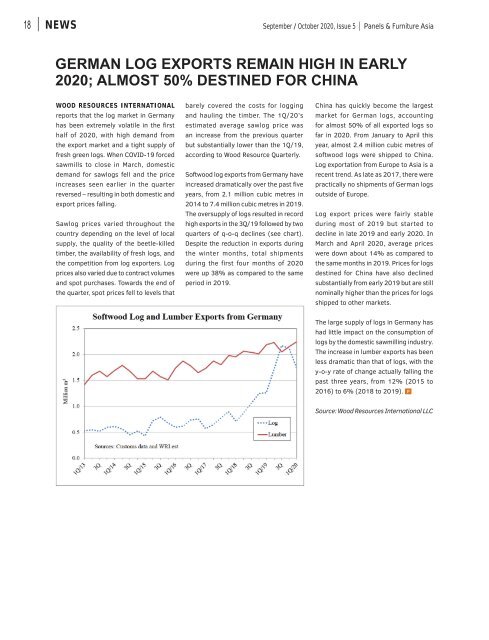Panels & Furniture Asia September/October 2020
Panels & Furniture Asia (PFA) is a leading regional trade magazine dedicated to the woodbased panel, furniture and flooring processing industry. Published bi-monthly since 2000, PFA delivers authentic journalism to cover the latest news, technology, machinery, projects, products and trade events throughout the sector. With a hardcopy and digital readership comprising manufacturers, designers and specifiers, among others, PFA is the platform of choice for connecting brands across the global woodworking landscape.
Panels & Furniture Asia (PFA) is a leading regional trade magazine dedicated to the woodbased panel, furniture and flooring processing industry. Published bi-monthly since 2000, PFA delivers authentic journalism to cover the latest news, technology, machinery, projects, products and trade events throughout the sector. With a hardcopy and digital readership comprising manufacturers, designers and specifiers, among others, PFA is the platform of choice for connecting brands across the global woodworking landscape.
Create successful ePaper yourself
Turn your PDF publications into a flip-book with our unique Google optimized e-Paper software.
18 | NEWS<br />
<strong>September</strong> / <strong>October</strong> <strong>2020</strong>, Issue 5 | <strong>Panels</strong> & <strong>Furniture</strong> <strong>Asia</strong><br />
GERMAN LOG EXPORTS REMAIN HIGH IN EARLY<br />
<strong>2020</strong>; ALMOST 50% DESTINED FOR CHINA<br />
WOOD RESOURCES INTERNATIONAL<br />
reports that the log market in Germany<br />
has been extremely volatile in the first<br />
half of <strong>2020</strong>, with high demand from<br />
the export market and a tight supply of<br />
fresh green logs. When COVID-19 forced<br />
sawmills to close in March, domestic<br />
demand for sawlogs fell and the price<br />
increases seen earlier in the quarter<br />
reversed – resulting in both domestic and<br />
export prices falling.<br />
Sawlog prices varied throughout the<br />
country depending on the level of local<br />
supply, the quality of the beetle-killed<br />
timber, the availability of fresh logs, and<br />
the competition from log exporters. Log<br />
prices also varied due to contract volumes<br />
and spot purchases. Towards the end of<br />
the quarter, spot prices fell to levels that<br />
barely covered the costs for logging<br />
and hauling the timber. The 1Q/20’s<br />
estimated average sawlog price was<br />
an increase from the previous quarter<br />
but substantially lower than the 1Q/19,<br />
according to Wood Resource Quarterly.<br />
Softwood log exports from Germany have<br />
increased dramatically over the past five<br />
years, from 2.1 million cubic metres in<br />
2014 to 7.4 million cubic metres in 2019.<br />
The oversupply of logs resulted in record<br />
high exports in the 3Q/19 followed by two<br />
quarters of q-o-q declines (see chart).<br />
Despite the reduction in exports during<br />
the winter months, total shipments<br />
during the first four months of <strong>2020</strong><br />
were up 38% as compared to the same<br />
period in 2019.<br />
China has quickly become the largest<br />
market for German logs, accounting<br />
for almost 50% of all exported logs so<br />
far in <strong>2020</strong>. From January to April this<br />
year, almost 2.4 million cubic metres of<br />
softwood logs were shipped to China.<br />
Log exportation from Europe to <strong>Asia</strong> is a<br />
recent trend. As late as 2017, there were<br />
practically no shipments of German logs<br />
outside of Europe.<br />
Log export prices were fairly stable<br />
during most of 2019 but started to<br />
decline in late 2019 and early <strong>2020</strong>. In<br />
March and April <strong>2020</strong>, average prices<br />
were down about 14% as compared to<br />
the same months in 2019. Prices for logs<br />
destined for China have also declined<br />
substantially from early 2019 but are still<br />
nominally higher than the prices for logs<br />
shipped to other markets.<br />
The large supply of logs in Germany has<br />
had little impact on the consumption of<br />
logs by the domestic sawmilling industry.<br />
The increase in lumber exports has been<br />
less dramatic than that of logs, with the<br />
y-o-y rate of change actually falling the<br />
past three years, from 12% (2015 to<br />
2016) to 6% (2018 to 2019). P<br />
Source: Wood Resources International LLC


















